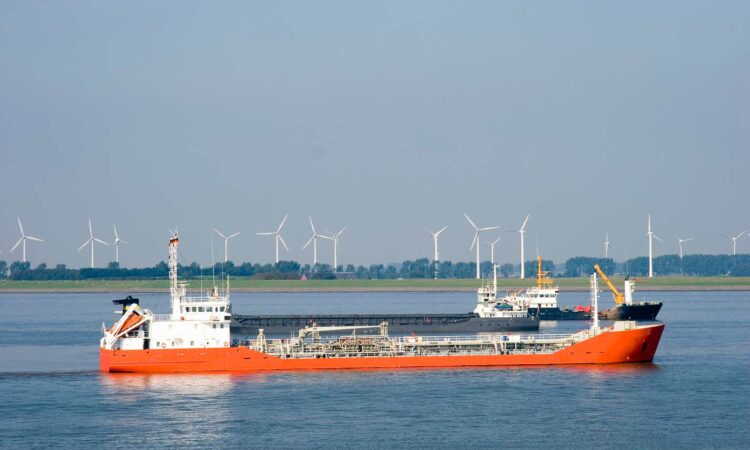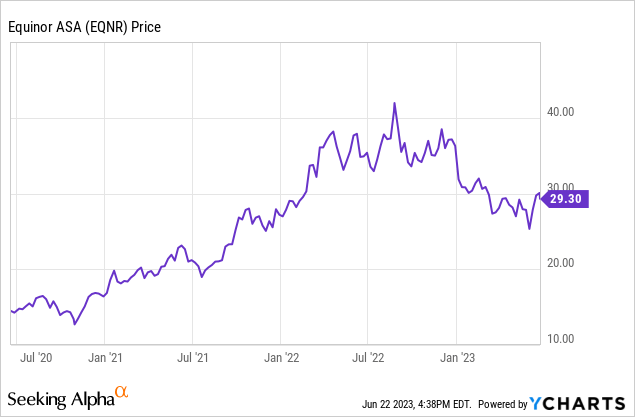

onfilm/iStock via Getty Images
I am downranking Equinor SA (NYSE:EQNR) from buy in my November 2022 report to hold.
Although the company’s market capitalization is down to $91.2 billion from $119.1 billion in my earlier report, Equinor does offer an attractive base (4.1%) plus variable (currently total 12.3%) dividend.
About two-thirds of the company’s equity is owned by the Norwegian pension fund. While the $1.4 trillion sovereign wealth fund has been generated from Equinor’s oil and gas profits, the fund has inexplicably aimed its environmental and governance activism at US energy companies Exxon Mobil (XOM) and Chevron (CVX).
Ironically, a rising environmental exposure for Equinor is its own wind projects off the US East Coast. More evidence remains to be gathered, but seismic surveys and construction for offshore wind projects appear to be correlated with a large increase in dead whales.
While Equinor is still a key natural gas supplier to Europe in lieu of Russia, weather, conservation, and alternative LNG supplies have combined to lower the gas price from the desperately high levels of 2022. Thus, based on current natural gas (and oil) prices, Equinor’s reserves are overvalued using the year-end 2022 prices, as much as by a factor of three for natural gas, and natural gas forms half the company’s reserves.
Governance
National oil companies (NOCs) are distinguished from international majors and super-majors in that NOCs are largely owned and controlled by their home-country government. Very often, a country’s governance targets for its NOC-in addition to providing substantial support for itself and its citizens-also trend toward non-economic or short-term policy goals.
On June 1, 2023, Institutional Shareholder Services ranked Equinor’s overall governance a 1, with sub-scores of audit (1), board (1), shareholder rights (6), and compensation (3). In this ranking a 1 indicates lower governance risk and a 10 indicates higher governance risk.
No insiders hold stock shares.
At May 31, 2023, shares shorted as the percentage of shares outstanding was a small 0.27%.
Equinor’s beta is 0.54, surprisingly low but a key factor is the ownership of a majority of shares by Norway’s sovereign wealth fund.
No large institutional investor holds more than 0.3% of Equinor’s stock.
The Norwegian government, through its $1.4 trillion (world’s largest) government pension fund, owns 67% of Equinor; thus, non-Norwegian individual investors’ incentives may not align with the Norwegian government’s incentives. Indeed, the Norwegian Government Pension Fund was expressly set up “to invest government revenues from fossil fuel industries into sectors deemed more sustainable in order to provide for a future when the country can no longer rely on its income from oil.”
While this is laudable from a diversification standpoint and is similar to sovereign wealth funds of other countries (and states, like Alaska), the recent action by the sovereign wealth fund contrary is somewhere between anti-hydrocarbon and anti-competitive.
Specifically, the Norwegian fund backed climate activists in 2023 shareholder votes against the management of Exxon Mobil and Chevron. It also opposed the CEOs of those companies remaining as board chairs. The Norwegian fund did not take a similar approach with Shell (SHEL) or BP (BP).
Wind and Whales
Given its offshore European expertise, Equinor is also involved in developing large wind projects in offshore US waters. In partnership with BP, Equinor is developing Empire Wind (80,000 acres 15-30 mile south of Long Island with up to 130 wind turbines) and Beacon Wind (128,000 acres, 60 miles east of Montauk Point and 20 miles south of Nantucket). Total capacity of both projects is 3.3 gigawatts. Equinor also won an auction to develop a floating wind project offshore California, Morro Bay.
All industrial developments encounter environmental issues. For offshore wind, there is concern that seismic surveying for and construction may be linked to an unusually large number of whale deaths on the US East Coast-36 between December 1, 2022 and May 8, 2023.
Macro
After sharp dislocations due to Russia’s invasion of Ukraine and follow-on sanctions, Europe’s oil, gas, and distillate situation is less dire than in the second half of 2022, leading to lower prices. During that time, as a known, reliable nearby supplier to Europe, Equinor was especially well-positioned.
Oil and Gas Prices
Brent oil’s price (European reference) is close to that of US WTI; indeed, WTI (at Midland, Texas not at Cushing, Oklahoma) is now a factor in the Platts Dated Brent price. European natural gas and liquefied natural gas prices have eased to far more normal levels in the last six months as conservation, warm winter weather, and alternative supplies combined to make the situation less dire, despite the loss of roughly 40% of European natural gas supply, which had been imported by pipeline from Russia.
LNG prices now are far below their 2022 peaks:
*$11.70/MMBTU at the UK’s NBP (National Balancing Point),
*$11.82/MMBTU at TTF (Title Transfer Facility) in the Netherlands, and
*$12.48/MMBTU for the JKM (Japan Korea Marker) Asian reference price.
Compare these to $2.61/MMBTU for the NYMEX price of US gas at Henry Hub.
And on the oil side, on June 22, 2023, the price of the NYMEX contract for:
*Brent crude oil (August 2023) was $74.05/barrel,
*West Texas Intermediate (August 2023) crude oil was $69.41/barrel
*US heating oil (July 2023) was $2.47/gallon, or $104/barrel.

First Quarter 2023 Results and Guidance
In the first quarter of 2023, Equinor earned $5.0 billion of net income. Net operating income was $12.6 billion (compared to $18.4 billion in 1Q22). Cash flow from operations was $15.3 billion. The company made the first of three $5.42 billion NCS (Norwegian Continental Shelf) tax payments; it expects to make two more in 2Q23.
In addition to its drilling and production, Equinor acquired Suncor Energy in the UK and solar project developer BeGreen.
Equinor divides into five primary operating segments. For 1Q23, the majority of net operating income came from Norwegian operations.
*Exploration & Production Norway, $9.8 billion,
*Exploration & Production International, $382 million,
*Exploration and Production USA, $340 million,
*Marketing, Midstream & Processing, $2.1 billion, and
*Renewables, loss of -$89 million.
Total production for 1Q23 averaged 2.13 million BOE/day of liquids and natural gas, about half liquids (mostly oil and some natural gas liquids). Equinor expects to deliver 3% production growth in 2023.
The company estimates organic capital expenditures of $10-11 billion for 2023 and $13 billion annually for 2024-2026.
Second quarter 2023 results will be announced July 26, 2023.
Reserves
On December 31, 2022, Equinor’s proved reserves were 5.191 billion barrels of oil equivalent (BOE). This included 2.248 billion barrels of oil and condensate (43.3%), 280 million barrels of natural gas liquids (5.4%), and 2.491 billion BOE (about 14.946 trillion cubic feet) of natural gas (51.3%).
The SEC PV-10 value of these reserves at December 31, 2022, was $88.4 billion, more than double the $43.8 billion reserve value as December 31, 2021.
The increase was due partially to an increase in proved reserves (larger volume economic to produce), but mainly due to calculations with an oil price that was 50% higher in 2022 compared to 2021 and a natural gas price that was more than 250% higher in 2022 compared to 2021 (and almost 1000% higher than the 2020 price).
*2022 oil price $100.30/bbl vs. 2021 oil price $67.61/bbl
*2022 gas price $30.66/MMBTU vs. 2021 gas price $11.89/MMBTU
Thus, with oil and gas prices lower and a less desperate inventory and supply situation, it is likely yearend 2023 reserve values will be lower than those for 2022.
Competitors
Equinor ASA is headquartered in Stavanger, Norway and most of its profits come from Norway.
Among other NOCs and near-NOCs, it competes with BP, Shell, Eni (E), TotalEnergies (TTE), Petrobras (PBR), Saudi Aramco (ARMCO), Qatar Energy, and others. It also competes with US internationals like Exxon Mobil, Chevron, and ConocoPhillips (COP).
As noted above, Equinor develops and operates wind projects and so also competes with other wind project owners.
Equinor’s Financial and Stock Highlights
Equinor’s market capitalization is $91.2 billion at June 22, 2023, stock closing price of $29.30/share.
The 52-week price range is $25.23-$42.53 per share, so the closing price is 69% of its 52-week high and 78% of the one-year target of $37.47/share.
Twelve-month (TTM) trailing EPS was $9.03/share for a current price/earnings ratio (P/E)of a bargain 3.2.
Returns on assets and equity are both stellar at 27.3% and 57.8%, respectively.
TTM operating cash flow is $34.2 billion. Levered free cash flow is $42.1 billion.

At March 31, 2023, Equinor had $95.3 billion in liabilities and $152.5 billion in assets for a liability-to-asset ratio of 63%.
The company’s ratio of debt to market capitalization is a small 0.34. The debt-to-EBITDA ratio is comfortable at 0.40.
Equinor’s regular dividend of $1.20/share represents a 4.1% yield. If variable dividends continued each quarter at the same rate as in 1Q23-quite unlikely-annualizing the additional quarterly special dividend of $0.60/share to $2.40/share/year would result in a total dividend yield of 12.3%.
One analyst rates Equinor as a “strong buy,” a second considers it very undervalued, and a third rates the company as “hold.”
Notes on Valuation
The company’s book value per share of $9.17 is much less than its market price, a positive indicator. The ratio of enterprise value to EBITDA is a mind-blowing low of 1.1-a huge bargain.
The ratio of market capitalization to production is $42,800/flowing BOE and $85,200/flowing barrel of liquids.
Comparing totals: the company’s SEC PV-10 reserve value at December 31, 2022, was $88.4 billion, enterprise value now is $86.4 billion, market capitalization now is $91.2 billion, and asset base on March 31, 2023, was $152.5 billion.
Positive and Negative Risks
The interests of the Norwegian government, including the directives of Equinor’s 67% stockholder, the Norwegian Government Pension Fund, may not align with energy investors who prefer more, or long-term, hydrocarbon investments. This is apparent not only from the fund’s mission statement but from its actions against the managements of Exxon Mobil and Chevron.
Political risk is an issue worldwide, from the EU and UK to Brazil to the US.
Investors should consider their European oil and natural gas price, supply, and demand expectations (including for European LNG) as the factors most likely to affect Equinor.
Recommendations for Equinor ASA
Equinor is an important baseload supplier of natural gas (and oil) to Europe. Unlike UK-headquartered companies, it is not subject to the UK’s 75% income tax rate for North Sea oil and gas producers, although it pays tax on production and the Norwegian pension fund owns 67% of the company’s equity.
The price/earnings ratio, dividend yield, share repurchases cash flow, and market proximity make Equinor attractive.
Crucially, however, investors can expect to soon see a smaller SEC PV-10 reserve value due to lower prices for both oil and-especially–natural gas, the latter of which is half of Equinor’s reserves.
While Equinor’s renewables segment is productive, it is not profitable. And, irony of ironies, the company may be environmentally (and so economically) exposed on US offshore wind projects. Perhaps Equinor will adopt Shell’s approach. Shell recently said renewables projects that don’t make returns will become candidates for sale.
Lower natural gas and oil prices from an overstuffed and reluctant-to-commit-to-hydrocarbons Europe, are negatives. Given that Norway’s $1.4 trillion sovereign wealth fund is sourced from Equinor’s oil and gas production, the fund’s environmental and governance activism against US companies Exxon Mobil and Chevron is, to put it politely, disingenuous.
I am downranking Equinor from buy to hold.

equinor.com






